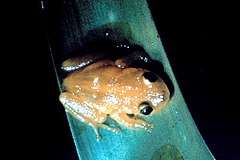Hyloidea
| Hyloids | |
|---|---|
 | |
| Eleutherodactylus jasperi | |
| Scientific classification | |
| Kingdom: | Animalia |
| Phylum: | Chordata |
| Class: | Amphibia |
| Order: | Anura |
| Suborder: | Neobatrachia |
| Superfamily: | Hyloidea Stannius, 1856 |
| Families | |
|
See text | |
Hyloidea is a superfamily of frogs.[1] Hyloidea accounts for 54% of all living anuran species.[2] The Hyloidea superfamily branched off from a common ancestor from the Neobatrachia suborder during the time of the Cretaceous-Paleogene extinction 66 million years ago. The fossil evidence found during this period of extinction could not determine the effects upon the frogs, due to the lack of fossils. Increased forestry erupted after this extinction, possibly leading to more arboreal adaptations of these anurans to be best suited for this habitat.[3]
It contains the following subgroups:[1][4]
- Alsodidae (Mivart, 1869) - (26 species)
- Batrachylidae (Gallardo, 1965) - (14 species)
- Brachycephaloides
- Brachycephalidae (Günther, 1858) - saddleback toads, flea toads and big-headed frogs (70 species)
- Craugastoridae (Hedges, Duellman, and Heinicke, 2008) - fleshbelly frogs (822 species)
- Eleutherodactylidae (Lutz, 1954)- rain frogs (223 species)
- Bufonidae (Gray, 1825) - true toads (603 species)
- Centrolenids
- Allophrynidae (Savage, 1973) - Tukeit Hill frogs (3 species)
- Centrolenidae (Taylor, 1951) - glass frogs (155 species)
- Ceratophryidae (Tschudi, 1838) - common horned frogs (12 species)
- Cycloramphidae (Peters, 1862) - glass frogs (36 species)
- Dendrobatoidea
- Dendrobatidae (Cope, 1865) - poison frogs (194 species)
- Aromobatidae (Grant, Frost, Caldwell, Gagliardo, Haddad, Kok, Means, Noonan, Schargel & Wheeler, 2006) - cryptic forest frogs (121 species)
- Hemiphractidae (Cope, 1865) - (112 species)
- Hylidae (Rafinesque, 1815) - treefrogs (711 species)
- Hylodidae (Günther, 1858) - (47 species)
- Leptodactylidae (Werner, 1896 (1838)) - southern frogs (206 species)
- Odontophrynidae ( Lynch, 1969) - (53 species)
- Rhinodermatidae (Bonaparte, 1850) - Darwin's frogs or mouth-brooding frogs (3 species)
- Telmatobiidae (Fitzinger, 1843) - water frogs (63 species)
Shared Characteristics of Hyloidea
Hyloidea is the largest superfamily of anurans due to scientists placing frogs into this family when the relationships to others are unknown.[2] Therefore, Hyloidea has the highest species diversity. Hyloidea are all tailless, have shortened bodies, large mouths and muscular hind legs. Most anurans in the superfamily have a lateral‐bender which is a type of pelvis morphology found in walking, hopping and burrowing frogs. Some species that appear later in the taxon have a sagittal‐hinge pelvis found in aquatic frogs as well as walking, hopping and burrowing frogs and some have a fore–aft slider pelvis found in terrestrial frogs.[5]
Phylogenic Relationships
The morphological characteristics between anurans are very similar, therefore DNA testing was used to further the understanding of the relationships within Hyloidea as technology progressed. After the ML and Bayesian analyses were conducted, using a Nuclear Marker Toolkit, to review the relationships of the Hyloidea superfamily on a molecular level, the results were shocking as they found clear evidence that resolves some of the relations of the anurans in Hyloidea. As they tested 55 relationships of the Hyloidea and was found that 53 out of the 55 previously established nodes on the phylogenetic tree were supported by this DNA testing.[2]
References
- 1 2 R.Alexander Pyron, John J.Wiens, 2011, A large-scale phylogeny of Amphibia including over 2800 species, and a revised classification of extant frogs, salamanders, and caecilians "Archived copy" (PDF). Archived from the original (PDF) on 2012-12-18. Retrieved 2013-04-22.
- 1 2 3 Feng, Yan-Jie; Blackburn, David C.; Liang, Dan; Hillis, David M.; Wake, David B.; Cannatella, David C.; Zhang, Peng (2017-06-28). "Phylogenomics reveals rapid, simultaneous diversification of three major clades of Gondwanan frogs at the Cretaceous–Paleogene boundary". Proceedings of the National Academy of Sciences: 201704632. doi:10.1073/pnas.1704632114. ISSN 0027-8424. PMID 28673970.
- ↑ Meijer, Hanneke (2017-08-02). "Jump for joy: researchers make huge leap in understanding frog evolution". the Guardian. Retrieved 2018-04-02.
- ↑ The Amphibian Species of the World 6.0 website of the American Museum of Natural History's
- 1 2 Jorgensen, M. E.; Reilly, S. M. (2013-05-01). "Phylogenetic patterns of skeletal morphometrics and pelvic traits in relation to locomotor mode in frogs". Journal of Evolutionary Biology. 26 (5): 929–943. doi:10.1111/jeb.12128. ISSN 1420-9101.